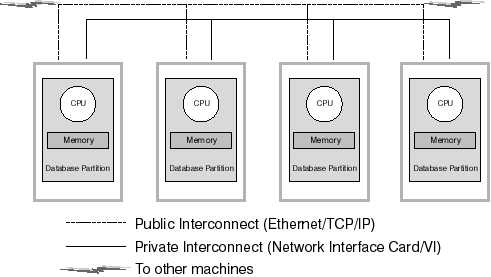

Virtual Interface (VI) Architecture is the inter-node communication protocol alternative to TCP/IP in a Windows NT massively parallel processing (MPP) environment. VI is a new communication architecture that was developed jointly by Intel, Microsoft, and Compaq to improve performance over a System Area Network (SAN). Refer to http://www.viarch.org for more information on the architecture.
Products exist which may be acquired separately from DB2 UDB that have a VIA-enabled network interface card (NIC), switch, and software driver implementation. Several Independent Hardware Vendors (IHVs) have released, or plan to release, such products.
Figure 109. Network Interface Card and Protocol
 |
As shown in Figure 109, there are some similarities between the Public Interconnect which uses as an example Ethernet and TCP/IP and the Private Interconnect which uses a Network Interface Card and a protocol.
The Network Interface Card and protocol used in this instance could be either a GigaNet Network Interface Card and the VI protocol; or a ServerNet Network Interface Card and the VI protocol.
VI Architecture has low latency and high bandwidth. In a communication-intensive environment, using VI Architecture improves the overall system throughput. The greater the number of nodes in the cluster, and the greater the amount of data transferred, the greater the benefit from using VI Architecture.
DB2 UDB supports VI Architecture implementations that comply with the Virtual Interface Architecture Specification, Version 1.0; the Intel Virtual Interface (VI) Architecture Developers' Guide, Version 1.0; and pass the "Virtual Interface Architecture Conformance Suite". The specification is found at http://www.intel.com/design/servers/vi/the_spec/specification.htm on the Web. The Developer's Guide is found at http://www.intel.com/design/servers/vi/developer/ia_imp_guide.htm on the Web. Information on the conformance suite is also found at this same URL.